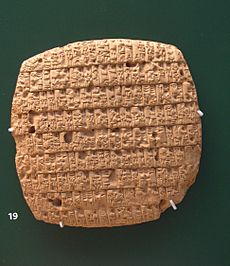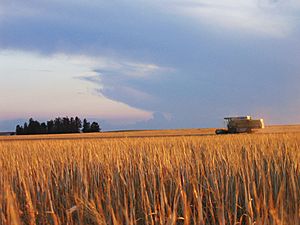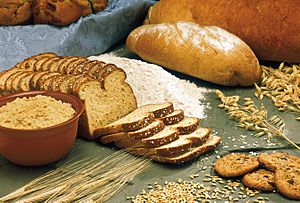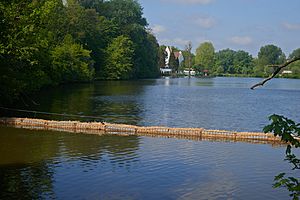Barley facts for kids
Quick facts for kids Barley |
|
|---|---|
 |
|
| Barley field | |
| Scientific classification | |
| Kingdom: | |
| Division: | |
| Class: | |
| Order: | |
| Family: | |
| Genus: |
Hordeum
|
| Species: |
H. vulgare
|
| Binomial name | |
| Hordeum vulgare |
|
Barley is a type of plant. Its seeds are a cereal grain. People and animals eat it. It is one of the oldest crops grown by humans. You can make flour or beer from it.
Its Latin name is Hordeum vulgare. Barley is an annual plant, meaning it lives for one growing season.
Contents
The Story of Barley

Barley was one of the very first grains grown by people. This happened in the Fertile Crescent, a region in Western Asia with lots of water. It also grew near the Nile river in Africa. Barley appeared around the same time as other early grains like einkorn and emmer wheat.
Wild barley grows from North Africa to Tibet. It was a very important food in ancient Egypt. Egyptians used barley to make bread and beer.
Barley was also a main grain in ancient India. People found traces of barley farming from 5700 to 3300 years ago. This was during the Indus Valley civilization.
In ancient Rome, gladiators were sometimes called hordearii, which means "barley-eaters." This shows how important barley was to their diet. Later, wheat became more common than barley in Roman times.
In Tibet, barley has been a staple food since the 5th century CE. People roast barley flour and mix it with butter and butter tea. This makes a dough that they eat in small balls.
During the Middle Ages in Europe, poor people ate bread made from barley and rye. Richer people ate wheat products. In the 1800s, potatoes largely replaced barley in Eastern Europe.
Where Barley Grows Today
| Top Barley Producers in 2014 | |
|---|---|
| Country | Amount (millions of tonnes) |
|
|
|
|
|
|
|
|
|
|
|
|
|
|
|
|
|
|
|
|
|
|
|
|
|
|
|
|
|
|
In 2014, the world produced 144 million tonnes of barley. The Russian Federation grew 14% of this total. France and Germany were also big producers.
How Barley is Grown
Barley can grow in many different places. It is popular in cool areas as a summer crop. In warmer, tropical areas, it is planted in winter. Its seeds usually sprout in one to three days.
Barley grows well in cool weather. However, it does not handle very cold winters as well as some other grains.
Barley can grow better in salty soil than wheat. This might be why more barley was grown in Mesopotamia a long time ago. Barley also has a short growing season and can handle dry conditions.
Barley Plant Health
Barley plants can get sick from certain viruses and bacteria. But plant scientists are working hard to make new types of barley that can fight off these diseases.
Barley as Food
What's in Barley?
A 100-gram serving of raw barley has 352 calories. It is full of important nutrients. These include protein, dietary fiber, and B vitamins like niacin and vitamin B6.
Barley also has many important dietary minerals. It has a lot of manganese and phosphorus. Raw barley is mostly carbohydrates (78%), with some protein (10%), fat (1%), and water (10%).
How Barley is Prepared
When barley is harvested, it has a tough outer shell. This shell is removed to make "hulled barley." This is a whole grain because it still has its healthy bran and germ.
"Pearl barley" is hulled barley that has been processed more. It is steamed and polished to remove the bran. Both hulled and pearl barley can be made into flour, flakes (like oatmeal), or grits.
Barley flour is used in porridge and gruel in Scotland. In the Arab world, a barley gruel is called sawiq. Barley is used in many traditional Middle Eastern dishes. These include soups and stews. For example, barley soup is often eaten during Ramadan in Saudi Arabia.
In Eastern and Central Europe, barley is also used in soups and stews. In Africa, barley is a traditional food that can help improve nutrition.
Health Benefits of Barley
Eating barley can be good for your health. Health experts say that eating enough barley can help lower blood cholesterol. High cholesterol can be a risk factor for heart problems.
Eating whole-grain barley can also help control blood sugar levels. This means it can help your body respond better after you eat a meal. Eating breakfast cereals with barley for a few months can also improve cholesterol and blood sugar.
However, like wheat and rye, barley contains gluten. This means people with celiac disease or other gluten-related disorders should not eat barley.
Barley Drinks
Drinks with Alcohol
Barley is a main ingredient in making beer and whisky. Two-row barley is often used for German and English beers. Six-row barley was traditionally used for US beers, but now both types are common.
Whisky is made from fermented grains. In Ireland and Scotland, whisky is mostly made from barley. About 25% of the barley grown in the United States is used for malting. Malting is a process that prepares the grain for making drinks.
Drinks without Alcohol
People also make non-alcoholic drinks from barley. One example is barley water, made by boiling barley in water.
In Italy, roasted and ground barley is used to make caffè d'orzo, which means "barley coffee." It tastes like coffee but has no caffeine. It became popular when coffee was hard to get, like during World War II. Now, it's a favorite coffee alternative for many Italians, especially if they want to avoid caffeine.
Other Uses for Barley
Animal Food
About half of the barley grown in the United States is used to feed farm animals. Barley is an important animal feed in many parts of the world, especially in cooler northern areas. It is the main feed grain in Canada, Europe, and the northern United States.
In 2014, scientists found a way to make high-protein fish food from barley. This food is good for fish that eat meat, like trout and salmon.
Fighting Algae
In England, people put barley straw in mesh bags and float them in fish ponds. This is thought to help reduce algae growth without harming other pond plants or animals. However, studies have shown mixed results on how well it works.
Measurement
Long ago in England, barley grains were used for measurement. Three or four "barleycorns" made an inch. This old unit of measurement still affects shoe sizes in Britain and the USA today.
Modern studies show that a single barley kernel can be from 4 to 15 millimeters long. This depends on the specific type of barley.
Cultural Importance
The Islamic prophet Muhammad suggested barley for certain health issues. It was also believed to help calm the stomach. An ancient doctor named Avicenna wrote about the healing effects of barley water and soup for fevers.
In English folklore, there is a famous folksong about "John Barleycorn." This character is a personification of barley itself. The song tells how John Barleycorn suffers attacks and "dies," which represents the different steps of growing and processing barley.
Images for kids
See also
 In Spanish: Cebada para niños
In Spanish: Cebada para niños















